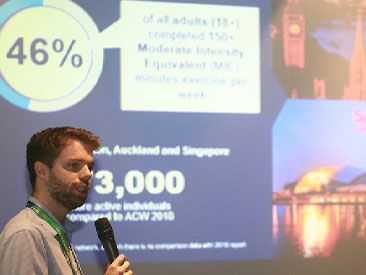health & active lifestyle
Active Citizens Worldwide: Empowering policy-makers through data analysis

Share this post
Active Citizens Worldwide (ACW) is a global initiative established to help cities across the world address this challenge, and achieve a step-change in physical activity levels for their citizens. Since its launch in 2018, ACW has unearthed compelling evidence that sheds light on the complex systemic interplay between socio-economics, demographics, policy and physical activity. It has enabled cities to use data and insights for better policy-making, and perhaps most importantly, ACW has provided proof of concept that it is possible to systematically fill that data void.
This article draws on the 2019 ACW Annual Report recently launched at the ACW Conference in Singapore. It features ACW analysis from the cities of Auckland, London, Singapore and Stockholm conducted by leading global management consultancy, Portas Consulting.
At the heart of ACW is the use of data. Every modern city is awash with huge amounts of data in the form of sports participation surveys, attitudinal surveys, membership data, facility databases, censuses, academic research, etc. The power of the model lies not in the analysis of any one of these sources, but in bringing everything together in one place, and seeing what we can learn when we overlay and analyse data in a single system approach. The ACW approach is broken down into three parts:
- the analysis of physical activity itself (type, duration, intensity, frequency)
- the analysis of the drivers of physical activity (socio- demographics, policies)
- the analysis of the outcomes of physical activity (economic, social, health)
Sport and physical activity – an uneven playing field
The most striking picture that has emerged over the last two years is the clear correlations between physical activity participation and socio-demographics, in particular inequalities related to socio- economics, gender and ethnicity. Moreover, the similar trends have consistently been seen across all four cities.
“Physical activity and sport offer a clear opportunity to improve people’s lives, but it is vital that we work purposefully to ensure that people from every background and of every age are able to enjoy its many lifelong benefits.” – Tim Copley, Director of Insight, Technology & Data – London Sport
- Well-off individuals are up to 1.7 times more likely to be active than those worse-off. Data from all cities clearly reflect the fact that participation is in part driven by money, time and access. Inequalities in participation, and hence inequalities in accessing the benefits of physical activity, will contribute to a widening of social inequality if left unaddressed.
- Inequality is often exacerbated by age. In Auckland, well-off individuals aged 25-49 are almost twice as likely to be active than those less well-off of the same age. As developed economies face ageing populations, the inequalities in participation will continue to grow.
- Differences are driven by life stage, not age. Physical activity behaviour is heavily driven by life stages rather than absolute age. How people react at each life stage depends on their environment and could be linked to broader cultural factors. In London and Auckland, activity drops off alarmingly once people retire. In Singapore, entry into the workforce seems to be the brake, but activity picks up once they retire. The right policies can keep people moving through each of their life stage, whatever the age.
- There is a gender gap, and it is more pronounced across certain ethnicities. In London, Auckland and Singapore, we see men are more active than women, though the gap is narrowing. Overlaying the lens of ethnicity, there are significant differences in the gender gap across different ethnic groups. The implication for policymakers is the need to tailor policy and programming to the needs of specific ethnic groups.
- Interest, motivation and willingness do not seem to be the primary reason for differences in activity levels. Over 60% of inactive people in London say they enjoy exercise, particularly in the Asian community. In Singapore, around 18% of the population remain insufficiently active despite saying they want to participate in sport regularly. While this may reflect other practical barriers, campaigns such as “This Girl Can” in the UK identified other motivational factors, e.g. fear of judgement as being a fundamental barrier to participation, despite genuine desire to be active.
Designing the right interventions: facilities matter
Facilities make up a major part of the policy-makers’ arsenal, and ACW analysis has confirmed that availability and accessibility of facilities is correlated with levels of physical activity.
Across all cities, access to facilities is related to activity level
More active local areas have on average of up to 2.5 times more facilities than less active areas across the four cities. However, the most impactful type of facilities differs from city to city.
Low-cost facilities are critical in addressing inequalities
There is a clear relationship in London and Singapore between the activity levels of low-income groups and access to public facilities (a relationship not seen for other economic groups). While this should not come as a surprise, it is an important reminder that cost is a major barrier to access for the least active socio-economic groups.
Active recreation vs functional activity
In London and Auckland, higher socio-economic groups participate in more recreational and sporting activities compared to lower socio-economic groups who spend more time on functional activities (e.g. walking for travel). While the pure physiological benefits of physical activity may not discriminate in terms of recreation or function, recreational sports and activities offer greater social benefits and well-being. Activity for leisure is a relative luxury, and facilities need to be developed in such a way to enable recreational activity even for those who may be limited by time, energy and money.
“Active Citizens Worldwide has given us a common language with our colleagues in the health, economic and social sectors as we discuss the design and contribution of sport and physical activity” – Huei Chern Lee, Head of Strategic Comms and Insights – Sport Singapore.
The true value of sport and physical activity
Working with academics and experts, ACW has quantified the monetary and non-monetary value of physical activity for over a dozen metrics covering economic, health and social dimensions.
- Physically active individuals report that they are 6% happier, are 28% more trusting of community, report 6% higher life satisfaction, and show 14% lower psychological distress levels.
- Physical activity contributes a combined estimated US$14bn to the economies of Auckland, London, Singapore and Stockholm, generating US$1.6bn in healthcare savings and US$0.5bn in productivity savings.
- In terms of positive social interaction, analysis from Singapore has shown that for every one hour spent doing sport, 48 minutes were spent with others, compared to 23 minutes for those doing just exercise. This highlights the potential importance of the type of activity having an important impact on social cohesion and integration.
The ability to place a value on physical activity and calculate a “social return on investment” has been a game-changer for the cities. It has enabled policy-makers to effectively lobby for increased investment in sport – an additional NZ$150m commitment in Auckland’s case – by demonstrating the return.
“ACW has helped us use the data we have better, and to fill gaps in our knowledge, so that we can advocate more effectively and encourage more evidence-based decision making and investment for Auckland.” – Nicola Gamble, Insights Manager – Aktive Auckland Sport & Recreation
This also has significant implications for cities hosting major events. Currently, many cities are increasingly struggling to justify the cost of hosting a major game, as we have seen for the Summer Olympics in 2024 and 2028. In the future, cities can use ACW to credibly set a baseline before, measure the impact during, and calculate the social and economic legacy after a major event. In doing so, not only will cities be able to build a robust case for bidding or hosting an event but will have the detailed information to plan the event in such a way so as to maximise the social impact.
Looking ahead
ACW has already started to inform and impact important decisions for the cities. In the years to come, as the number of cities in the network increases, the quantity, quality and accuracy of the insights will grow. Year-to-year data will start to inform emerging trends, and over time, we can start to understand the impact of specific policy interventions, while continuing to advocate for the social power of sport.
“Innovation and development are key words for the city of Stockholm to better meet the needs of the citizens. When resources and space are limited, it is crucial to know how to create the highest value. ACW is a great way to use global knowledge for local achievements” – Peter Ahlstrom, Chief of Staff – Stockholm Stad Sports Administration (City of Stockholm)
ACW started by trying to address a gap in data. We now see that the power of the model is more than that – it is a global platform for change that brings together ambitious global cities to collaborate, share, support and innovate. In fact, it is the platform for every city in the world that believes in the transformational power of sport and physical activity.



